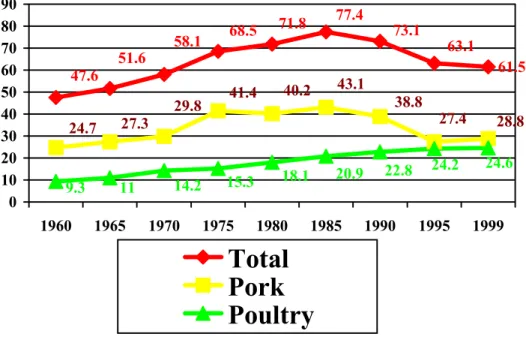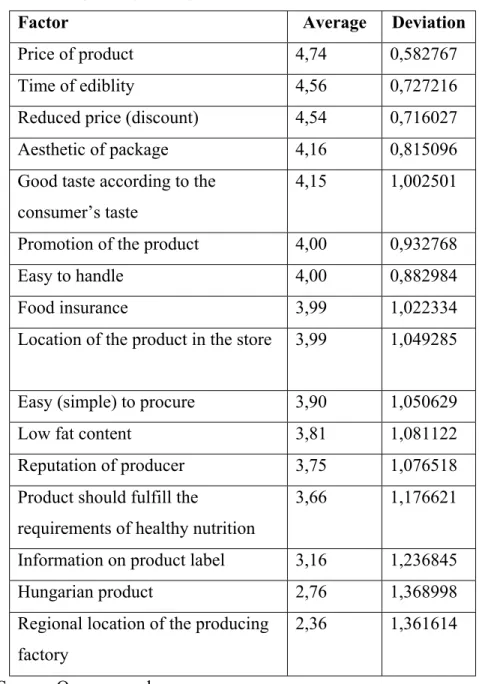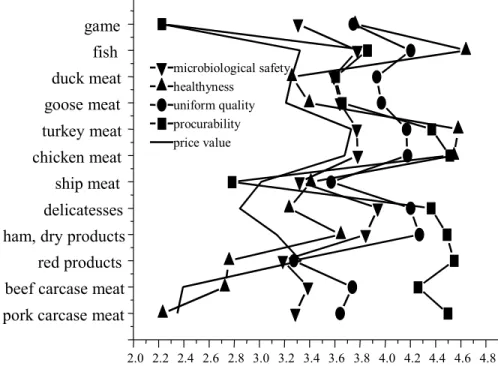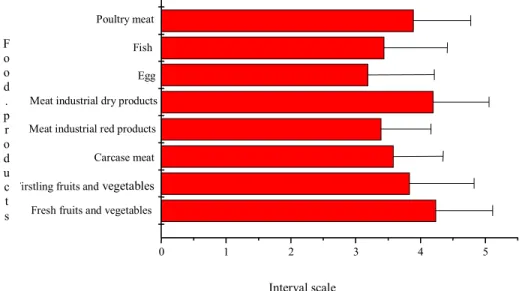UNIVERSITY OF WEST-HUNGARY
FACULTY OF AGRICULTURAL AND FOOD SCIENCES DEPARTMENT OF AGRICULTURAL ECONOMICS AND
MARKETING
Program leader: Consultant:
Dr. Dr. h.c. Iváncsics János Dr. Tenk Antal University teacher University teacher Doctor of Hungarian Academy Candidate ofagricultural sciences of Science
MEAT BUYING BEHAVIOUR IN HUNGARY ON THE TURN OF THE MILLENNIUM
Author:
PÉNZES ÉVA
Mosonmagyaróvár 2002
1. ANTECEDENTS AND OBJECTIVES OF THE RESEARCH
Nowadays factors influencing food consumption – such as supply, income, demographical characteristics, consumer prices and consumer preferencies, promotion – are more and more in the focus of scientific research. Market and leader actors of Hungarian agricultural economics often face the fact, that in the future only that market strategy can be succesful, which accepts the importance of product development, the selection of distribution channels, price policy, consumers’ demand in the formation of communication strategy and flexibly adapts to the changind domestic market conditions.
In the past decade some radical historical changes occured in the Hungarian food industry, that inspire the reconsideration of the traditional food industrial modells. The following conditions should be emphasized:
1. The dinamic change in the domestic solvent demand.
From the middle of the eightees a considerable decrease can be observed in the demand of food products.
2. Demand segregation, product segmentation is stronger regarding the whole population. The formerly characteristic average consumer is diminishing, and it is replaced by consumer groups with different income and demand levels, who expect the satisfaction of their differentiated demands.
3. The change in domestic demand is more considerably influenced by the continuous increase of food import.
4. The topic of food security is getting more attention and interest.
On basis of the above described, a complex evaluation is necessary regarding the adjustment of domestic consumers to different meat products, regarding their consumer habits and behaviour.
Relatively little information is available about the whole of food consumption in Hungary, and only a limited knowledge is available regarding the domestic consumption, consumer buying behaviour of meat products. This topic is chosen in order to clearify these questions and to reveal the connections. The novelty of the research is that it maps the Hungarian meat consumption situation from the viewpoint of retailers, based on their experiences. The shop managers and retailers are in everyday contact with the consumers, and they are expected to know the consumers’ attitute, habits and opinions.
Besides the detailed investigation of the under written elements the dissertation evaluates several questions:
1. the introduction of meat consumption in Hungary (structure and volume of consumption);
2. the investigation of factors and conditions that form and influence the buyers’ and consumers’ decisions;
3. role of food safety, origin of product and health consciousenness in buyers’ decisions;
4. the relation between buyer decisionmaking mechanism and marketing communication;
5. to gain information on meat consumption habits and consumer behaviour, how the received data can be utilized by the market participants;
6. the role of factors influencing meat consumption habits (price, availability, quality, how it fits into up-to-date nutritional habits, microbiological ensurance);
7. factors influencing meat consumption in the future in Hungary.
2. MATERIAL AND METHOD Selection of methods
Two possibilities were examined in relation to the evaluation of the possible methods: the collection and utilization of secondary and primer informastion.
With consideration of the objectives the direct, primer market research and the survey of consumer opinions seemed to be the most reasonable. The two possibilities were: direct questions to the consumers, or questions to shop managers and shop assistants that may reveal several novel results.
As we expected several advantages regarding asking the shop managers and retailers, this method was chosen. This way the opinion of shop managers and retailers about the consumers, the buyers’ habits can be recognized.
Description of the research method
1. The representatives of the food industrial company that performed the investigation visited the shop managers, in retail chain stores the person responsible for meat and meat products.
2. Shop managers had two weeks to fill in the questionnaires.
The investigation was performed in year 2000. Alltogether 1000 shops were involved. The number of returned questionnaires was 409, which is cinsidered to be above the average number of returned
questionnaires, and the distribution reflected the shop network of the country favourably.
3. In the elaboration of the questionnaire the following main elements were considered:
- The composition od the questionnaire should be simple, easy to understand. Where possible, the so-called closed questions should be used.
- Questions and answers should be codable for the computer data processing. After the numbering of the returned questionnaires the data were registered on the computer on basis of codes with the Excel software.
- The mathematical – statistical evaluation should be made with three softwares: the SPSS, Statistica and Origin integrated mathematical-statistical programs. On basis of mathematical-statistical evaluations partly one variable tests and evaluations were performed, but in some cases the multi variable mathematical-statistical process were needed. The connections were determined with significancy tests.
Statistical evaluation of the stores
In the first phase of the investigation the statistical characteristics of the stores to be chosen were evaluated. The tables show the geopgraphical distribution (Table 1) of the stores and their characteristics regarding the sold meat products (Table 2).
Table 1: Location of stores of the asked shop managers and retailers
Location of the store
Relative frequency of answers (%) Near or close to a busy road 26,98 26,98
In a village 24,87
In a housing estate area 15,87
Near traditional town appartement houses 11,11 In the green belt, area of houses with gardens
10,05
Near busy intersection 5,82
In suburban industrian district 3,17
On promenade 1,06
In shopping centre 0,53
In any institute 0,53
Alltogether 99,99 Source: Own research
Table 2: Characteristics of stores regarding the sold meat product type
Product type Relative
frequency of answers (%)
Dry- and butcher’s meat 47,3
Carcase meat, dry- and butcher’s meat 46,8
Only dry product (delicates) 5,9
Alltogether 100,0 Source: Own research
3. RESULTS
Introduction of current situation of meat consumption in Hungary The whole food industry, and its one major sector the meat industry faced considerable changes since the system transformation. One of the most significant change in food consumption was the drastic decrease of meat- and meat product consumption per head in the past two decades (Figure 1).
Not only the quantitative reduction of meat- and meat products, but also the total change of meat consumption structure can be observed in this period. The rate of pork and poultry meat consumption reversed in ten years. Poultry meat took the lead, pork lost its position and due to the BSE crisis the already low beef and veal consumption decreased even further.
Figure 1: Meat purchusing in Hungary, macrostatistic (1960-1999)
(M.U.: kg/head/year)
Source: KSH (Central Statistical Office)
The change in consumption structure rises several questions to meat industry, that should be answered with the better understanding of consumption habits, the reveal of the buyers’ decision making mechanism and the lightening of meat market tendencies.
Factors influencing the buyers’ decisions
The investigation justified that the picture is quite compound regarding meat consumption habits in Hungary and also regarding the buying decision.
47.6 51.6 58.1 68.5 71.8 77.4
73.1 63.1
61.5
24.7 27.3 29.8 41.4 40.2 43.1
38.8 27.4 28.8
24.2 24.6
9.3 11 14.2 15.3 18.1 20.9 22.8
0 10 20 30 40 50 60 70 80 90
1960 1965 1970 1975 1980 1985 1990 1995 1999
Total
Pork Poultry
Table 3: Factors and conditions influencing the buying behaviour of the consumer, evaluated on a 1-5 interval scale regarding meat products
Factor Average Deviation
Price of product 4,74 0,582767
Time of ediblity 4,56 0,727216
Reduced price (discount) 4,54 0,716027
Aesthetic of package 4,16 0,815096
Good taste according to the consumer’s taste
4,15 1,002501 Promotion of the product 4,00 0,932768
Easy to handle 4,00 0,882984
Food insurance 3,99 1,022334
Location of the product in the store 3,99 1,049285 Easy (simple) to procure 3,90 1,050629
Low fat content 3,81 1,081122
Reputation of producer 3,75 1,076518 Product should fulfill the
requirements of healthy nutrition
3,66 1,176621 Information on product label 3,16 1,236845
Hungarian product 2,76 1,368998
Regional location of the producing factory
2,36 1,361614
Source: Own research
In domestic terms the most important factors are the price of product, the period of edibility and temporal price reductions, the so-called discounts (Table 3). The fourth most important factor was the aesthetic and handeablity of package, its importance was equal to the taste of the product. The promotion activity of the food product also received a relatively high, 4 value, similar to the easy handeability. The location of the product in the store and also food insurance received also relatively high values. A new and considerable phenomenon is, that the satisfaction of the requirements of up-to-date nutritional habits receive more attention. According to our investigation the consumer does not lay store by the origin of the product, wether it is produced in Hungary or not.
Advantages deriving from the acquaintance of consumer habits and behaviour
In this phase of the research retailers, shop assistants were asked to determine the influencing possibility and role of the family members on buying meat products. According to the results it is evident, that among young couples without children the role of the housewife is determinative. The influence of the parents can still be felt. Among people living in rural areas the role of women is even
more important in buying meat and meat products, but this applys to the consumers in the capital to a much less extent. In families with children no considerable deifference can be observed regarding the decision making role of husband or wife, at the same time they consider the demands of the child in their meat buying decisions.
The older couples that live apart from their children represent a specific consumer group. A very determinative shift can be observed in the direction of husbands in the buying decision making procedure.
Consumers’ judgement of different meats and meat products A part of the questions on the questionnaire applied to the consumers’ judgement of meat products, how they judge the different meats and meat products, the main market quality characteristics, and before all the quality. (Figure 2).
The figure shows the image profile analysis of different meat based on the received answers, concerning microbiological safety, healthyness, uniform quality, procurability and price/value. Fish, turkey meat, chicken meat, delicatesses and ham types products, dry products received a relative favourable judgement, but the values of pork carcase meat and red products got very unfavourable values. The figure also includes several information that is worth to think further.
Figure 2: Image profile analysis of different meats
Source: Own research
Information sources that influence meat buying decisions pork carcase meat
beef carcase meat red products ham, dry products
delicatesses ship meat chicken meat turkey meat goose meat duck meat fish game
2.0 2.2 2.4 2.6 2.8 3.0 3.2 3.4 3.6 3.8 4.0 4.2 4.4 4.6 4.8 score - value
microbiological safety healthyness
uniform quality procurability price value
The investigation also included questions regarding what information effects the consumers’ decisions nowadays and in the near future.
It seems, that the most important information source that influences the consumers is promotion. The second most important influencing factor is the effect of other family members. It is interesting, that retailers and shop managers consider their consumer influencing effect to be more important, than other information sources. The asked shop managers ascribe a relatively little significance to professional publications or cooking consultants. The role of family doctors received a relativels small importance as well.
Consumers and food safety
Food safety means a complex system in order to avoid the damage of the comsumers’ health with the commercialized product. The next phase of the research focused on how healthy or harmless the consumers consider the products from different procurement places.
Consumers have a relatively high confidence in the products that can be bought in commercial units. Consumers have less confidence in animal products originating from small scale facilities. They accept the role of up-to-date agricultural large- scale operations in the production of products with reliable quality.
According to the opinion of the shop managers consumers are mistrustful regarding home pig slaughterings and processing.
Compared to that the industrial scale meat processing and production received a significantly better evaluation.
Risk factors of food safety
Table 5: Evaluation of risk factors on a sequence scale in connection with food products
Risk factors Sequence average
Deviation Chemical residues 4,25 2,212 Natural poisons from fodder 4,76 2,233 Contamination originating
from the meat processing
4,95 2,570
Microbiological contamination
5,03 2,558 Meat industrial additives 5,40 2,945
Animal medicins 5,42 2,255
Technological contamination
5,69 3,043 Packing materials 6,00 3,031
Radiating materials 6,04 3,479
Hormon residues 6,28 2,964
Source: Own research
Risk means the recongition, evaluation and treatment of possible damage for the consumers’ health. It is important to examine how consumers considers the certain risk factors during their buying. The relative importance of risk factors is shown on Table 5.
Evaluating the risk factors of certain food products on human health one can draw important conclusions from the conditions, that how the risk characteristics of the food products are considered by the asked people (Figure 3).
Figure 3: Security of certain raw- and processed agricultural and food products; evaluated on 1-5 interval scale
Source: Own research
Fresh fruits and vegetables Firstling fruits and vegetables
Carcase meat Meat industrial red products Meat industrial dry products Egg Fish Poultry meat
0 1 2 3 4 5
Interval scale F
o o d
. p r o d u c t s
Factors influencing the probable meat consumption in Hungary The questionnaire regarding this phase searches an answer on what factors are of a great importance in the quantitative decrease of meat consumption.
From the received answers it can be stated, that the decrease of living standard, the increase of consumer prices are considered to be very important. As a substitute to the more expensive pork and beef the poultry meat is mentioned. It is also clear that the changing nutritional habits are also of a great importance.
The role of the increasing quality problems are also reflected in the answers. Younger consumers less and less prefer the traditional meat products. The investigation also included questions regarding the evaluation of new changes, tendencies, such as organic products, domestic products, low energy content and environemt friendly production.
Most asked people agree that consumers are willing to pay more for organic products, although its quality is not better than the traditional product. Opinions varied very considerably regarding the question, that consumers will look for domestic products. Primarily the shop managers in the capital are more pessimistic in the increase of demand for dmonestic products in the coming years. The third question applied to the low energy content;
how consumers will look for this characteristic in the future. Data
were homogeneous and showed the growing importance of low energy products. The future role of environment friendly products was also evaluated favourably by the answers.
On can conclude from the answers, that one of the most significant problem of Hungarian meat industrial marketing is the decrease of demand for pork, and the negative image in connection with pork consumption.
Answers indicated the ideas or images regarding pork; both negative and positive type concepts were included among the 16 recited words.
According to the answers the judgement of pork is generally negative. In connection with pork the traditional Hungarian eating habits, fattening and numerous illnesses, high fat content and rich nutrient effect comes into the consumers’ mind.
4. NEW OR NOVEL RESULTS OF THE RESEARCH
4.1. Meat consumption habits of the Hungarian population have changed considerably in the past ten years, and this changing is still under process.
Domestic meat and meat product consumption decreased drastically in the past decade. Not only a quantitative change, but also a structural modification ca be observed. The consumption rate of pork and poultry meat have has exchanged. Poultryí meat took the lead and pork lost from its position. The changes were due to several factors. The decrease of the living standards, the increase of consumer prices, the preference of poultry meat instead of the more expensive pork or beef, the growing importance of healthy lifestyle together contributed to the above described process. That was supported by the opinion of the answers of the responsive people.
4.2. The hierarchy and mechanism of buying decision making have changed inside the family.
One determinative information for the participants of the meat industry is the role of family members in decision making process of meat and peat product purchase. The marketing experts can only elaborate and operate their marketing strategy, promotion effectively in the acquaintance of the target group. According to the results of the research the target groups differs regarding the
different age groups – as the family type is alo different in the age groups.
4.3. There is no significant difference in the acquaintenance of quality parameters between the town dwellers and people living in rural areas.
During the research the judgement of different meats and meat products was investigated, the judgement based on defined principles. It can be stated that the domestic opinions – irrespectively of the geographical location – are relatively homogeneous.
Quality production can be the outbreak point for meat industry, because only with quality product can it be competitive in the inner and also on “export” markets of the European Union. It is expected that the better quality product will be appreciated by the more and more demandive consumer, because due to statistical data the slow increase of solvent demand has already begun. The demandive consumer group will enlarge, and the consumer group that accepts lower quality will narrow.
4.4. Health and food safety are linked together for more consumers and become a basic viewpoint in the buying decision making.
According to the investigation the adequacy to modern nutritional habits and food safety become more focal factors in the decision making procedure of meats and meat products.
4.5. More and more consumers are aware of the meaning of organic products, and they are willing to pay a higher price for such products – irrespectively of the quality.
It is in relation with the above described elements, and also reflects teh future tendencies. It is expected that with the increase of living standards the demand for organic products will increase also in the meat and meat product category.
4.6. Most consumers are influenced basicly by the price and quality, and they do not prefer the meat products based on its domestic origin (brand).
A specific result is, that consumers do not favour domestic products in their purchase. It can have a considerable economic effect on the food industrial sectors, especially on meat industry afterwards the EU accession.
5. PRACTICAL APPLICABILITY OF THE RESULTS OF THE RESEARCH
5.1. The acquaintance of the dynamism of consumer habits and buyers behaviour can serve as a basis for the forecast of market potency of different meat products.
The acquaintance of potential buyers and consumers can mean several advantages for meat processing companies. The product development can only be successful with thorough information on consumer habits and buyers behaviour.
5.2. On basis of market potential the meat industry can achieve long term product- and technolgical development.
Product development is in connection with technological developments. In many cases new meat products and the development of the related technology mean high costs. The acquaintance of market potential can make these elements profitable for the companies, but also can mean high losses.
5.3. The micro level (differentiated) acquaintance of buyers behaviour can serve as a reliable basis for market segmentation adn also for product positioning.
The investigation introduces buyer behaviour forms and decision making mechanisms that can be used by the companies in the
elaboration of their short- and long term product positioning and market segmentation policy.
5.4. The thorough acquaintance of the players of buying decision making procedure may assist to the elaboration of a more differentiated (therefore more objective oriented) marketing strategy.
Marketing communication can only be successful if the information is distributed to the suitable target group. Promotion costs can only be effective, if we know the players of the buying decision making procedure well, we can adjust the certain products to them, and choose an effective channel for establishing contacts with them.
5.5. The information and results are especially useful for small and medium sized meat processor (and meat supplyer) companies, for the elaboration of coordinations that strenghten their competitiveness, and the elaboration of the collective marketing actions.
According to experiences small and medium sized companies adjust to market changes more flexibly. Speed is vary valuable among the competitive comanies. Large scale companies can react to challenges slowly, often because of their system, company structure, and the reaction requires more time. All market participants can benefit from the acquaintance of market tendencies.
5.6. The results of the research serve with important arguments for the elaboration of measures regarding the reputation, image and protection of domestic products by the time of the EU accession.
On the threshold of the EU accession a deliberate, system oriented marketing policy can only be successful. Companies should strenghten the image of domestic products in the consumers. An effective tool can be the protection and promotion of traditional, location (origin) oriented products. Quality will bew a basic – almost a natural – criteria on the EU market, and this should be more considered in the future.
6. SCIENTIFIC PUBLICATIONS AND PRESENTATIONS FROM THE TOPIC OF THE DISSERTATION
1 PÉNZES, É. (1998): Meat and meat product consumption in the past decade in Hungary
2 PÉNZES, É. (1999): Ecpected tendencies of meat and meat product consumption in Hungary between 2000-2005.
(Georgikon Scientific Days)
3 PÉNZES, É. – RÉTI, A. (2000): Expected ... of meat and meat product consumption
4 PÉNZES, É. (2000): Effect of meat product branding on Hungarian consumption habits, and the expected tendency of changes regarding the EU accession (VII. International Agrar- economical Scientific Days)
5 RÉTI, A. – PÉNZES, É. (2001): Expected trends of world pork production. Gazdálkodás, 2000. 2. sz. 43-50.p.
6 PÉNZES, É. – LAKNER, Z. (2001): Meat consumer behavour in the eyes of food retailers. Gazdálkodás, 2001. 3.sz.
különkiadása 76-88.p.
7 GODA, M. – KALMÁRNÉ HOLLÓSI, E. – VARGA, A. – NÉMETH, A. – LUKÁCS, G. – PÉNZES, É.(2001): Quality and competitiveness of Hungarian food products on the EU market (Poster)




